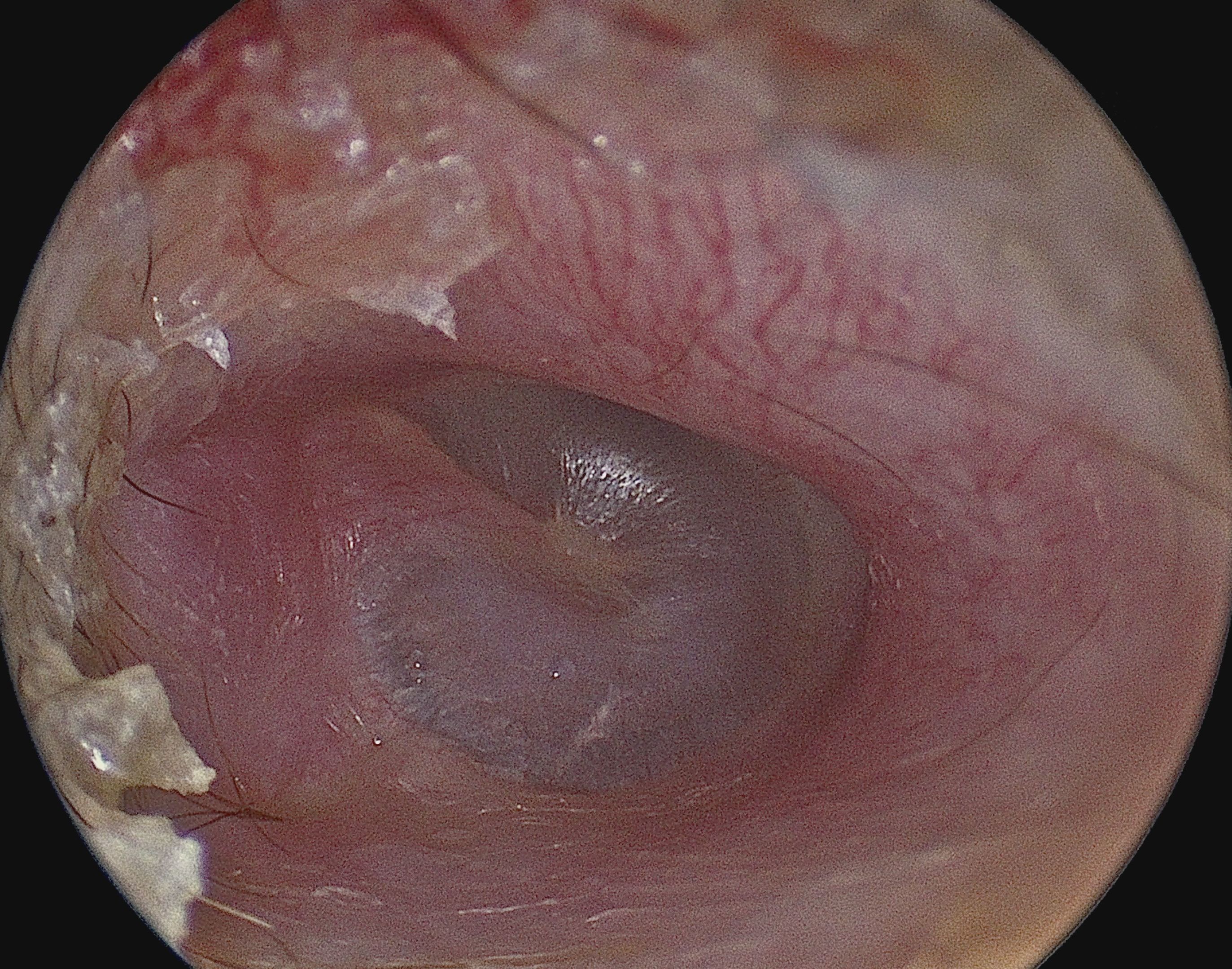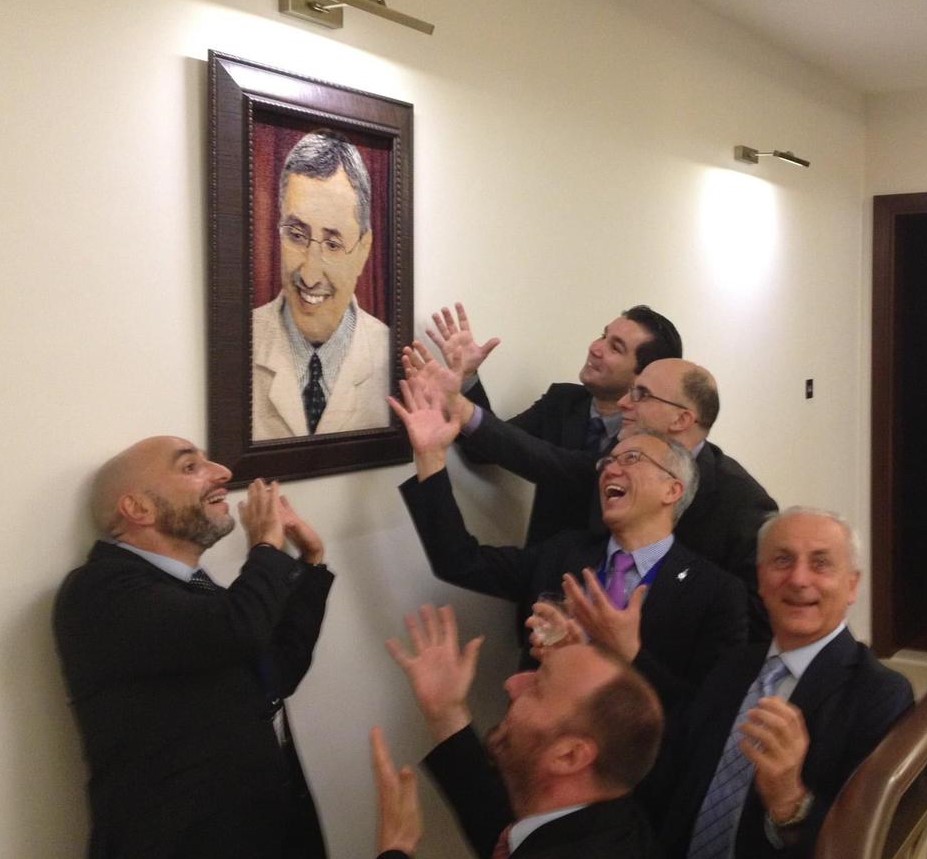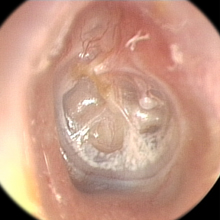|
Tympanoplasty
Tympanoplasty is the surgical operation performed to reconstruct hearing mechanism of middle ear. Classification Tympanoplasty is classified into five different types, originally described by Horst Ludwig Wullstein (1906–1987) in 1956.Wullstein, H. (1956), Theory and practice of tympanoplasty. The Laryngoscope, 66: 1076–1093. # Type 1 involves repair of the tympanic membrane alone, when the middle ear is normal. A type 1 tympanoplasty is synonymous to myringoplasty. # Type 2 involves repair of the tympanic membrane and middle ear in spite of slight defects in the middle ear ossicles. # Type 3 involves removal of ossicles and epitympanum when there are large defects of the malleus and incus. The tympanic membrane is repaired and directly connected to the head of the stapes. # Type 4 describes a repair when the stapes foot plate is movable, but the crura are missing. The resulting middle ear will only consist of the Eustachian tube and hypotympanum. # Type 5 is a repair involv ... [...More Info...] [...Related Items...] OR: [Wikipedia] [Google] [Baidu] |
Perforated Eardrum
A perforated eardrum (tympanic membrane perforation) is a prick in the eardrum. It can be caused by infection ( otitis media), trauma, overpressure (loud noise), inappropriate ear clearing, and changes in middle ear pressure. An otoscope can be used to view the eardrum to diagnose a perforation. Perforations may heal naturally or require surgery. Presentation A perforated eardrum leads to conductive hearing loss, which is usually temporary. Other symptoms may include tinnitus, ear pain, vertigo, or a discharge of mucus. Nausea and/or vomiting secondary to vertigo may occur. Causes A perforated eardrum can have one of many causes, such as: * Infection ( otitis media). This infection may then spread through the middle ear and may reoccur. * Trauma. This may be caused by trying to clean ear wax with sharp instruments. It may also occur due to surgical complications. * Overpressure (loud noise or shockwave from an explosion). * Inappropriate ear clearing. * Flying with ... [...More Info...] [...Related Items...] OR: [Wikipedia] [Google] [Baidu] |
Myringoplasty
Myringoplasty is the closure of the perforation of pars tensa of the tympanic membrane. When myringoplasty is combined with removal of scar tissue, it is called tympanoplasty. The operation is performed with the patient supine and face turned to one side. The graft material most commonly used for the surgery is temporalis fascia. The tragal cartilage and tragal perichondrium are also used as the graft by some surgeons. Myringoplasty restores hearing loss in certain cases of tinnitus. The chances of re-infection and persistent discharge is less after surgery. Myringoplasty should not be performed if there is active discharge from the middle ear, or if the patient has uncontrolled nasal allergy, or when the other ear is dead and in children less than 3 years of age. Myringoplasty is often done under general anaesthesia, but it can be done under local anaesthesia also. Technique of surgery Underlay technique The temporalis fascia is grafted. An incision is made along the edge of th ... [...More Info...] [...Related Items...] OR: [Wikipedia] [Google] [Baidu] |
Tympanostomy Tube
Tympanostomy tube, also known as a grommet, myringotomy tube, or pressure equalizing tube, is a small tube inserted into the eardrum via a surgical procedure called myringotomy to keep the middle ear aerated for a prolonged period of time, typically to prevent accumulation of fluid in the middle ear. The tube itself is made in a variety of designs, most often shaped like a grommet for short-term use, or with long flanges and sometimes resembling a T-shape for long-term use. Materials used to manufacture the tubes are often made from fluoroplastic or silicone, which have largely replaced the use of metal tubes made from stainless steel, titanium, or gold. Medical uses Inserting tympanostomy tubes is one of the most common pediatric surgical procedures in the United States, with 9% of children having had tubes placed sometime in their lives. Tympanostomy tubes are typically placed in one or both eardrums to help children suffering from recurrent acute otitis media (ear infec ... [...More Info...] [...Related Items...] OR: [Wikipedia] [Google] [Baidu] |
Joseph Toynbee
Joseph Toynbee FRS (30 December 1815 Another son, Harry Valpy Toynbee (1861–1941), was the father of universal historian Arnold J. Toynbee, and archaeologist and art historian Jocelyn Toynbee. He died on 7 July 1866, at 18, Savile Row, Mayfair, while conducting experiments with prussic acid and chloroform as a remedy for tinnitus. Either one of these substances or their combination is to blame for his death. He was buried at St Mary's Church, Wimbledon, on 11 July 1866. Joseph's residence on the burial register was listed as Wimbledon. He lived at Beech Holme, Wimbledon. A drinking fountain dedicated to his memory stands near to his home. Career He performed studies on the functionality of the Eustachian tube and tympanic membrane, and developed a form of tympanoplasty to restore function to the latter when damaged. When St. Mary's Hospital was founded in Paddington, he a became an aural surgeon and a lecturer on ear diseaseshis course of clinical lectures being publ ... [...More Info...] [...Related Items...] OR: [Wikipedia] [Google] [Baidu] |
Endoscopic Ear Surgery
Endoscopic ear surgery (EES) is a minimally invasive alternative to traditional ear surgery and is defined as the use of the rigid endoscope, as opposed to a Operating microscope, surgical microscope, to visualize the middle and inner ear during otologic surgery. During endoscopic ear surgery the surgeon holds the endoscope in one hand while working in the ear with the other. To allow this kind of single-handed surgery, different surgical instruments have to be used. Endoscopic visualization has improved due to high-definition video imaging and wide-field endoscopy, and being less invasive, EES is gaining importance as an adjunct to microscopic ear surgery. History Endoscopic ear surgery was first described in 1992 by Professor Ahmed El-Guindy and pioneered by Dr Muaaz Tarabichi in Dubai during the late 1990s. His contributions to the field have led to him being recognized globally as the father of endoscopic ear surgery. He now lectures extensively on the topic worldwide. Simil ... [...More Info...] [...Related Items...] OR: [Wikipedia] [Google] [Baidu] |
Surgical Operation
Surgery is a medical specialty that uses manual and instrumental techniques to diagnose or treat pathological conditions (e.g., trauma, disease, injury, malignancy), to alter bodily functions (e.g., malabsorption created by bariatric surgery such as gastric bypass), to reconstruct or alter aesthetics and appearance ( cosmetic surgery), or to remove unwanted tissues (body fat, glands, scars or skin tags) or foreign bodies. The act of performing surgery may be called a surgical procedure or surgical operation, or simply "surgery" or "operation". In this context, the verb "operate" means to perform surgery. The adjective surgical means pertaining to surgery; e.g. surgical instruments, operating theater, surgical facility or surgical nurse. Most surgical procedures are performed by a pair of operators: a surgeon who is the main operator performing the surgery, and a surgical assistant who provides in-procedure manual assistance during surgery. Modern surgical operations typically ... [...More Info...] [...Related Items...] OR: [Wikipedia] [Google] [Baidu] |
General Anesthesia
General anaesthesia (UK) or general anesthesia (US) is medically induced loss of consciousness that renders a patient unarousable even by painful stimuli. It is achieved through medications, which can be injected or inhaled, often with an analgesic and neuromuscular blocking agent. General anaesthesia is usually performed in an operating theatre to allow surgical procedures that would otherwise be intolerably painful for a patient, or in an intensive care unit or emergency department to facilitate endotracheal intubation and mechanical ventilation in critically ill patients. Depending on the procedure, general anaesthesia may be optional or required. No matter whether the patient prefers to be unconscious or not, certain pain stimulus, pain stimuli can lead to involuntary responses from the patient, such as movement or muscle contractions, that make the operation extremely difficult. Thus, for many procedures, general anaesthesia is necessary from a practical point of view. The p ... [...More Info...] [...Related Items...] OR: [Wikipedia] [Google] [Baidu] |
Myringotomy
A myringotomy is a surgical procedure in which an incision is created in the eardrum (tympanic membrane) to relieve pressure caused by excessive buildup of fluid, or to drain pus from the middle ear. A tympanostomy tube may be inserted through the eardrum to keep the middle ear aerated for a prolonged time and to prevent reaccumulation of fluid. Without the insertion of a tube, the incision usually heals spontaneously within two to three weeks. Depending on the type, the tube is either naturally extruded in 6 to 12 months or removed during a minor procedure. Those requiring myringotomy usually have an obstructed or dysfunctional eustachian tube that is unable to perform drainage or ventilation in its usual fashion. Before the invention of antibiotics, myringotomy without tube placement was also used as a major treatment of severe acute otitis media (middle ear infection). Nomenclature The words ''myringotomy'', ''tympanotomy'', ''tympanostomy'', and '' tympanocentesis'' overlap ... [...More Info...] [...Related Items...] OR: [Wikipedia] [Google] [Baidu] |
Eardrum
In the anatomy of humans and various other tetrapods, the eardrum, also called the tympanic membrane or myringa, is a thin, cone-shaped membrane that separates the external ear from the middle ear. Its function is to transmit changes in pressure of sound from the air to the ossicles inside the middle ear, and thence to the oval window in the fluid-filled cochlea. The ear thereby converts and amplifies vibration in the air to vibration in cochlear fluid. The malleus bone bridges the gap between the eardrum and the other ossicles. Rupture or perforation of the eardrum can lead to conductive hearing loss. Collapse or retraction of the eardrum can cause conductive hearing loss or cholesteatoma. Structure Orientation and relations The tympanic membrane is oriented obliquely in the anteroposterior, mediolateral, and superoinferior planes. Consequently, its superoposterior end lies lateral to its anteroinferior end. Anatomically, it relates superiorly to the middle crani ... [...More Info...] [...Related Items...] OR: [Wikipedia] [Google] [Baidu] |
James Yearsley
James Yearsley (1805–1869), aural surgeon, was born in 1805 to a north-country family settled in Cheltenham. Medical career Adopting a medical career, he became a pupil of Ralph Fletcher of Gloucester, (a surgeon of considerable eminence in his profession, and of some note as a collector of pictures), and later married his daughter. Yearsley moved to London, where he entered himself a student at St. Bartholomew's Hospital. He was admitted a member of the Royal College of Surgeons of England and a licentiate of the Society of Apothecaries in 1827; later in life he added to these qualifications the licentiateship of the Royal College of Physicians, Edinburgh (1860), and he graduated M.D. at St. Andrews University in 1862. After practising for a short time in Cheltenham, he established himself about 1829 as a general practitioner at Ross in Herefordshire. He removed to London about 1837, and started to practise as an aural surgeon. He opened an institution for the relief of di ... [...More Info...] [...Related Items...] OR: [Wikipedia] [Google] [Baidu] |
Pig's Bladder
A pig bladder or pig's bladder is the urinary bladder of a domestic pig, similar to the human urinary bladder. Today, this hollow organ has various applications in medicine, and in traditional cuisines and customs. Historically, the pig bladder had several additional uses, all based on its properties as a lightweight, stretchable container that could be filled and tied off. Traditional uses The pig bladder has several traditional ceremonial uses in Europe. It is traditional during the festival Fasching in Bad Aussee to brandish inflated pig bladders on sticks. Similarly, in Xinzo de Limia, Spain, inflated pig bladders are carried during Carnival. See also Clown society and Jester and Gigantes y cabezudos and Vejigante. In traditional Germanic communities a public Schlachtfest (of a pig) is announced by hanging the pig's inflated bladder in front of the host establishment. The bladder is used as a casing for several traditional food items, including the sausages known ... [...More Info...] [...Related Items...] OR: [Wikipedia] [Google] [Baidu] |
Ivory
Ivory is a hard, white material from the tusks (traditionally from elephants) and Tooth, teeth of animals, that consists mainly of dentine, one of the physical structures of teeth and tusks. The chemical structure of the teeth and tusks of mammals is the same, regardless of the species of origin, but ivory contains structures of mineralised collagen. The trade in certain teeth and tusks other than elephant is well established and widespread; therefore, "ivory" can correctly be used to describe any mammalian teeth or tusks of commercial interest which are large enough to be carved or scrimshawed. Besides natural ivory, ivory can also be produced synthetically, hence (unlike natural ivory) not requiring the retrieval of the material from animals. Tagua nuts can also be carved like ivory. The trade of finished goods of ivory products has its origins in the Indus Valley. Ivory is a main product that is seen in abundance and was used for trading in Harappan civilization. Finished iv ... [...More Info...] [...Related Items...] OR: [Wikipedia] [Google] [Baidu] |






